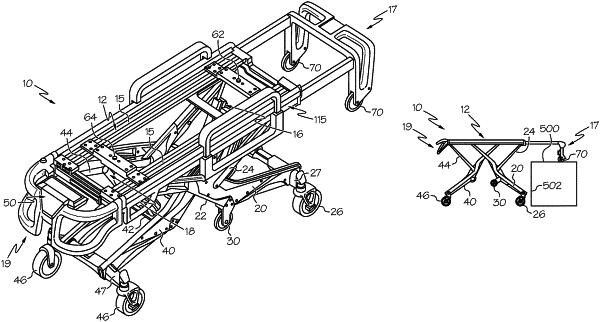| CPC A61G 1/0262 (2013.01) [A61G 1/0212 (2013.01); A61G 1/0237 (2013.01); A61G 1/0256 (2013.01); A61G 1/04 (2013.01); A61G 1/0562 (2013.01); A61G 1/0567 (2013.01); A61G 7/012 (2013.01); A61G 13/06 (2013.01); A61G 2200/16 (2013.01); A61G 2203/42 (2013.01); A61G 2203/726 (2013.01)] | 9 Claims |

|
1. A method of automatically articulating a powered ambulance cot to load a patient into an emergency vehicle having a loading surface, the method comprising:
configuring the powered ambulance cot to comprise:
a support frame provided with a pair of front load wheels;
a pair of front legs each having a front wheel and an intermediate load wheel;
a pair of back legs each having a back wheel;
a cot actuation system; and
a cot control system which detects a presence of a signal requesting a change in elevation of the support frame and which is operably connected to the cot actuation system to control raising and lowering of the pair of front legs and the pair of back legs relative to the support frame;
raising the support frame with the cot actuation system to a height which places the front load wheels above the loading surface of the emergency vehicle in response to the cot control system detecting presence of a signal requesting the support frame be raised;
rolling the powered ambulance cot towards the emergency vehicle until the front load wheels are over the loading surface;
lowering the support frame with the cot actuation system until the front load wheels contact the loading surface in response to the cot control system detecting the presence of a signal requesting the support frame be lowered;
automatically raising the pair of front legs relative to the support frame with the cot actuation system until the front wheel of each of the pair of front legs is at or above the loading surface in response to the cot control system detecting both (a) a signal requesting the pair of front legs be raised and (b) the front load wheels being in contact with the loading surface;
rolling the powered ambulance cot farther onto the loading surface;
raising the pair of back legs relative to the support frame with the cot actuation system until the back wheels are at or above the loading surface in response to the cot control system detecting presence of a signal requesting the pair of back legs be raised; and
rolling the powered ambulance cot farther onto the loading surface.
|